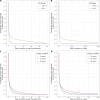Contrasting the impact and cost-effectiveness of successive intervention strategies in response to Ebola in the Democratic Republic of the Congo, 2018-2020
- PMID: 40234051
- PMCID: PMC12004461
- DOI: 10.1136/bmjgh-2024-015822
Contrasting the impact and cost-effectiveness of successive intervention strategies in response to Ebola in the Democratic Republic of the Congo, 2018-2020
Abstract
Introduction: The 10th outbreak of Ebola Virus Disease (EVD) in the Democratic Republic of the Congo (DRC) in 2018-2020 was the largest in DRC's history and the second largest worldwide. Different strategic response plans (SRPs) were implemented, and the outbreak was eventually stopped after a large scale-up of operations with the SRP 4, which benefited from all public health measures deployed during SRPs 1-3, upon which it developed a more holistic approach including community engagement, logistics and security.
Methods: We used modelling to characterise EVD transmission and assess the epidemiological impact of the two main response strategies (SRPs 1-3 vs SRP 4). We simulated potential future epidemics with different intervention scenarios, combined with a costing model to evaluate the incremental cost-effectiveness of different strategies.
Results: We estimated a mean effective reproduction number R of 1.19 (credible interval (95% CrI) = (1.13 ; 1.25)). The spatial spread was moderate with an average 4.4% (95% CrI = (3.5%; 5.4%)) of transmissions moving to different health zones. The scale-up of operations in SRP 4 coincided with a threefold reduction in transmission, and 30% faster control of EVD waves. In simulations, SRP 4 appears cost-saving, although most simulated outbreaks remain small even with SRPs 1-3.
Conclusion: Most EVD outbreaks are expected to be small and can be contained with SRPs 1-3. In outbreaks with increased transmissibility or in the presence of insecurity, rapid scale-up to SRP 4 is likely to save lives and be cost-effective.
Keywords: Health systems evaluation; Mathematical modelling; Viral haemorrhagic fevers.
© World Health Organization 2025. Licensee BMJ.
Conflict of interest statement
Competing interests: None declared.
Figures



Similar articles
-
A community-based contact isolation strategy to reduce the spread of Ebola virus disease: an analysis of the 2018-2020 outbreak in the Democratic Republic of the Congo.BMJ Glob Health. 2023 Jun;8(6):e011907. doi: 10.1136/bmjgh-2023-011907. BMJ Glob Health. 2023. PMID: 37263672 Free PMC article.
-
Sustainable strategies for Ebola virus disease outbreak preparedness in Africa: a case study on lessons learnt in countries neighbouring the Democratic Republic of the Congo.Infect Dis Poverty. 2022 Dec 2;11(1):118. doi: 10.1186/s40249-022-01040-5. Infect Dis Poverty. 2022. PMID: 36461100 Free PMC article.
-
Estimating the impact of violent events on transmission in Ebola virus disease outbreak, Democratic Republic of the Congo, 2018-2019.Epidemics. 2019 Sep;28:100353. doi: 10.1016/j.epidem.2019.100353. Epub 2019 Jul 26. Epidemics. 2019. PMID: 31378584 Free PMC article.
-
Impact of Ebola epidemics on the daily operation of existing systems in Eastern Democratic Republic of the Congo: a brief review.J Med Econ. 2024 Jan-Dec;27(1):184-192. doi: 10.1080/13696998.2024.2305009. Epub 2024 Jan 22. J Med Econ. 2024. PMID: 38240249 Review.
-
Indirect Effects of Ebola Virus Disease Epidemics on Health Systems in the Democratic Republic of the Congo, Guinea, Sierra Leone and Liberia: A Scoping Review Supplemented with Expert Interviews.Int J Environ Res Public Health. 2022 Oct 12;19(20):13113. doi: 10.3390/ijerph192013113. Int J Environ Res Public Health. 2022. PMID: 36293703 Free PMC article.
References
-
- World Health Organization Ending an ebola outbreak in a conflict zone. [10-Jul-2020]. https://storymaps.arcgis.com/stories/813561c780d44af38c57730418cd96cd Available. Accessed.
MeSH terms
Grants and funding
LinkOut - more resources
Full Text Sources
Medical
